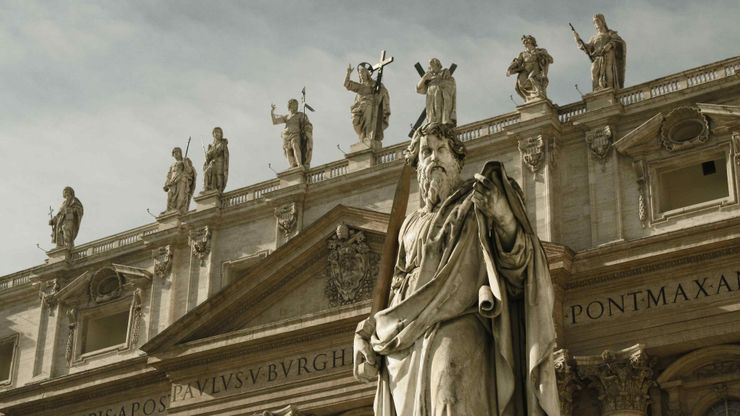Peter Heather's The Restoration of Rome
Peter Heather introduces his book, The Restoration of Rome.

Restoration picks up the story of Empire where my last book, The Fall of The Roman Empire left off, exploring the history of attempted imperial restoration through four protagonists: three individuals and an institution. None of the three individuals was quite what their spin doctors claimed . . .
'There, I told you he didn’t have a bone in his body . . . '
Theoderic the Goth liked to be seen as a philosopher in purple: the ideal ruler of long-established Greco-Roman cultural traditions. He first appears in history as a 7-year-old hostage sent to Constantinople by his (childless) uncle, at least in part to undermine his potential claim to the overall leadership of the uncle’s warband. In league with his father, however, he returned more than a decade later to win control first of the group and then to double it in size (despite the best attentions of the eastern Emperor Zeno), creating the military powerbase which allowed him to do an excellent impression of putting back together more than half of the old western Empire. But this self-styled divinely chosen philosopher king also an impressive line in terrible jokes. Having (literally) sliced a rival in half over dinner, he commented: “There, I told you he didn’t have a bone in his body…”
An ancient Martin Luther King
The second imperial wannabe – the eastern Roman Emperor Justinian – is usually presented as an ancient Martin Luther King: his dream was to restore Roman rule over its old western heartlands. But, equally romantically, his ambitions – which led to the conquests of Vandal North Africa, Gothic Italy, and parts of Visigothic Spain – are often thought to have paved the way for the Muslim Arab conquest of most of the east Roman heartland: a nasty dose of currently fashionable imperial overstretch. Neither myth holds. New research indicates that the fall of the eastern Empire cannot be realistically traced back to Justinian. His regime also stumbled into a reconquest policy by accident, having lost a major war (which it deliberately provoked) against Rome’s auld Persian enemy, and survived an insurrection which left 20,000+ dead in Constantinople, and the city’s monumental centre a smouldering ruin. Desperate to restore some prestige, Justinian reach tentatively towards a partial conquest in North Africa and found that the entire Vandal kingdom dropped into his lap, and a conquest 'policy' was born.
It was extremely bad form to declare yourself God's appointed ruler for the entirety of Christendom
Charlemagne’s story is a bit more like that of Theoderic since he went from modest beginnings to an imperial title. There is a big lie here is that he had never actually wanted to be emperor. It was put about by his biographer Einhard, and has been believed surprisingly often. But the evidence indicates that Charlemagne had been desperate for the title for a least a decade (and more probably two) before Christmas Day 800; he had to wait until he had enough leverage on the Pope to make him perform the ceremony, since it was extremely bad form to declare yourself, on your own initiative, God's appointed ruler for the entirety of Christendom. To prove himself worthy, Charlemagne set in motion reforms and endowments which revolutionised learning, piety and religious expectation right across the Empire. It also effectively sidelined the Pope within western Christianity, showing exactly why Leo III had to be blackmailed into the coronation.
The Roman Papacy
Each of these stories has its own fascination, but together they tell a bigger one. All three enjoyed huge success in their lifetimes, but none of these Empires long outlived their founders’ deaths. In post-Roman Europe, wealth and military capacity had become much too evenly distributed for central power to be exercised over wide areas in anything but the short term, and the productive capacities of the north had far outstripped the Mediterranean powerbase of the old Roman Empire. In these circumstances, as the final section of the book explores, viable supraregional power had to take an entirely new form: the Roman Papacy.
That the Papacy as we understand it now – CEO, effectively, of the Latin Church – has not always existed is the fact about medieval history which most surprises my students. What most surprised me, in writing the book, was the realisation that it was eventually created by consumer demand from outside Rome, and was not the product of some cunning plan hatched inside the Lateran. Charlemagne’s reforms created for the first time a Latin western Christendom which operated with self-consciously unified standards. When Charlemagne and his immediate heirs ran a big enough Empire to provide it, the Churchmen were happy to operate their unified church under imperial leadership. But when tenth-century political fragmentation set in, the heirs of Charlemagne’s reforming Churchmen looked elsewhere for the unified leadership this new Church required. The bishop of Rome was the only serious possibility, and, when existing Papal structures proved inadequate for the role, reform-minded eleventh-century Churchmen marched south from what old Rome’s barbarian north to make the Papacy fit for purpose.
A new authority
These are the barbarian Popes of the book’s subtitle, and, consciously modelling themselves on Roman law, they and their heirs generated a new authority structure with the Pope at the centre. In the first Roman Empire, as the conquered acquired citizenship, the spread of Roman law had allowed an institution created by conquest to re-establish itself on the basis of consent. The Papal Roman Empire originally emerged on the back of widespread consent, but its developing legal structures quickly created a medieval Christianity based firmly on constraint.
The Restoration of Rome

In 476 AD the last of Rome’s emperors was deposed by a barbarian general, the son of one of Attila the Hun’s henchmen, and the imperial vestments were despatched to Constantinople. The curtain fell on the Roman Empire in Western Europe, its territories divided between successor kingdoms constructed around barbarian military manpower. But if the Roman Empire was dead, the dream of restoring it refused to die. In many parts of the old Empire, real Romans still lived, holding on to their lands, the values of their civilisation, its institutions; the barbarians were ready to reignite the imperial flame and to enjoy the benefits of Roman civilization, the three greatest contenders being Theoderic, Justinian and Charlemagne. But, ultimately, they would fail and it was not until the reinvention of the papacy in the eleventh century that Europe’s barbarians found the means to generate a new Roman Empire, an empire which has lasted a thousand years.